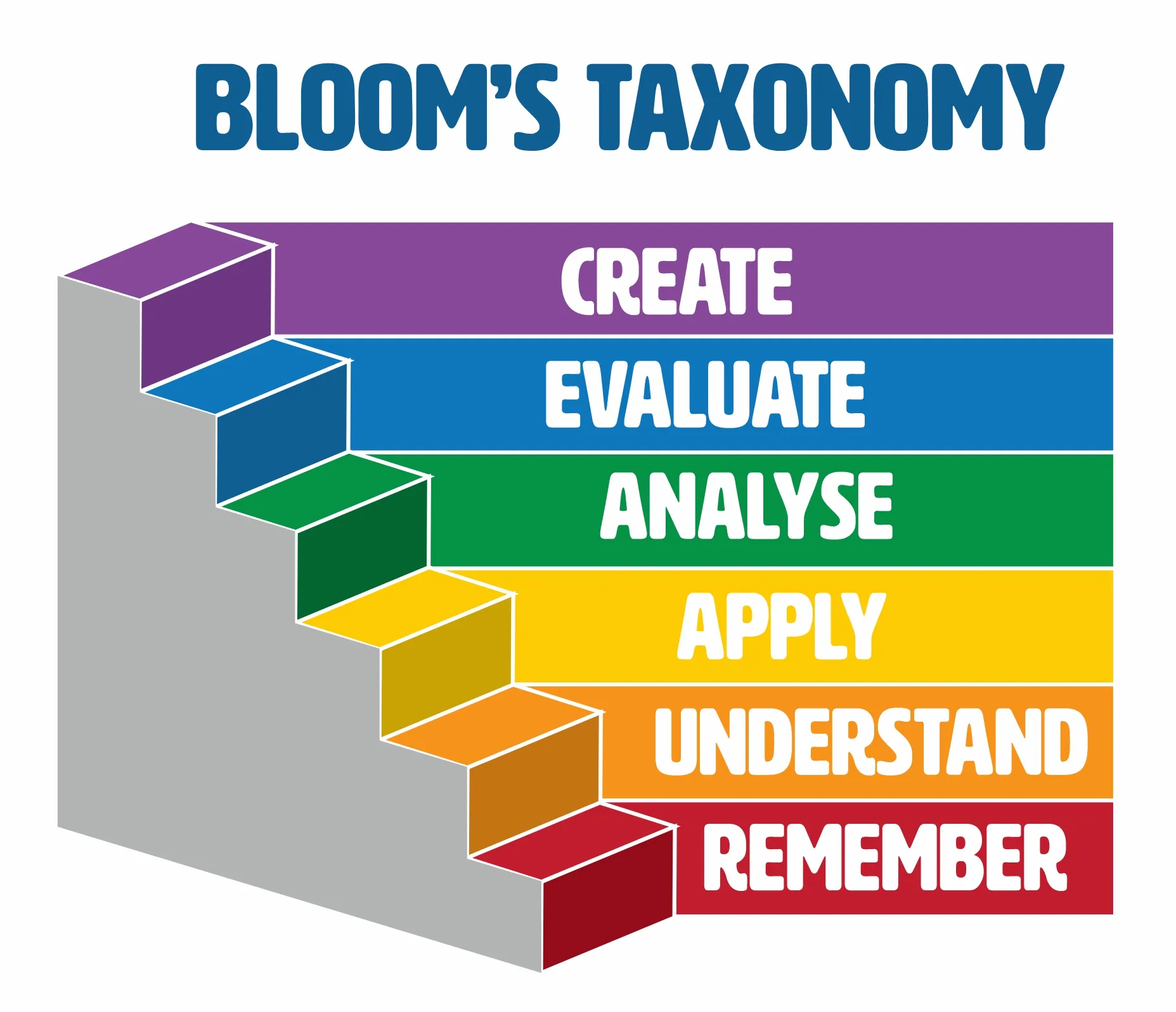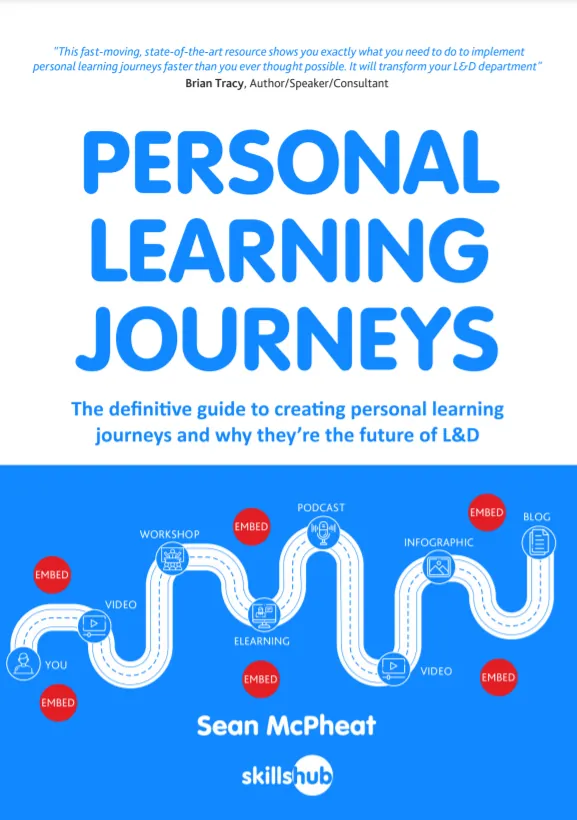
Have you come across Bloom’s Taxonomy before?
Bloom’s Taxonomy is a tried-and-tested framework that steers educators towards creating impactful, measurable learning objectives – stretching and challenging the boundaries of a learner’s thinking.
In this guide, we’ll be diving into the essence of this pedagogical theory to show you how to transform your approach to setting objectives, and to fuel a cycle of continual growth and innovation. With this hierarchy of cognitive skills as your ally, you can unlock the door to ingenious activities and assessments, propelling your learners to soar to unprecedented peaks of achievement!

Definition of Bloom’s Taxonomy
Developed in 1956 by Benjamin Bloom, an American educational psychologist, Bloom’s Taxonomy is one of the most popular strategies used by educators worldwide.
The Original Taxonomy of 1956
Bloom’s original taxonomy uses a multi-tiered system to establish the level of expertise needed to achieve specific outcomes. The groups are as follows:
- Knowledge: The ability to recall specifics and universals, methods and processes, or patterns, structures, and settings.
- Comprehension: An individual knows what’s being communicated to them and can utilise the material or idea without relating it to other materials or understanding all of its implications.
- Application: The ability to use abstractions in specific, concrete situations.
- Analysis: Breaking down communication into its constituent elements/parts, clarifying the hierarchy of ideas or relationships between them.
- Synthesis: Putting together elements and parts to form a whole.
- Evaluation: The ability to make judgments about materials’ values and the methods for specific purposes.
Bloom developed this system with his colleagues, Max Englehart, Edward Furst, Walter Hill, and David Krathwohl. They initially called it the Taxonomy of Educational Objectives.

Learn How To Create Personal Learning Journeys For FREE!
The Revised Taxonomy of 2001
Nearly 50 years later, in 2001, a group of researchers, psychologists, and curriculum theorists worked together to revise Bloom’s taxonomy of learning, renaming it A Taxonomy for Teaching, Learning, and Assessment. They argued that this title placed a greater emphasis on the dynamic aspects of classification.
To focus further on a more dynamic approach, they also renamed the levels of the taxonomy using verbs and gerunds (verbs used as nouns) for categories and subcategories. They believed that using action words was more fitting for the active cognitive processes learners use when learning.
The levels of the updated taxonomy are as follows:
Remembering (Recalling and recognising information):
- Recognising
- Recalling
Understanding (Explaining information and concepts):
- Interpreting
- Exemplifying
- Classifying
- Summarising
- Inferring
- Comparing
- Explaining
Applying (Using new information in specific situations):
- Executing
- Implementing
Analysing (Differentiating parts from a whole):
- Differentiating
- Organising
- Attributing
Evaluating (Making judgments based on specific criteria):
- Checking
- Critiquing
Creating (Making something new):
- Generating
- Planning
- Product



Learn How To Create Personal Learning Journeys For FREE!
The developers of this new taxonomy also created a separate one breaking down the various types of knowledge learners use in cognition. They are as follows:
Factual Knowledge:
- Knowledge of terminology
- Knowledge of specific details and elements
Conceptual Knowledge:
- Knowledge of classifications and categories
- Knowledge of principles and generalisations
- Knowledge of theories, models, and structures
Procedural Knowledge:
- Knowledge of subject-specific skills and algorithms
- Knowledge of subject-specific techniques and methods
- Knowledge of criteria for determining when to use appropriate procedures
Metacognitive Knowledge:
- Strategic Knowledge
- Knowledge about cognitive tasks, including appropriate contextual and conditional knowledge
- Self-knowledge
Like the different levels of Bloom’s taxonomy, this framework starts with the most basic form of knowledge and progresses to more complex ones.


Benefits of Using Bloom’s Taxonomy for Setting Learning Objectives
Both the original and revised versions of Bloom’s Taxonomy have been used for so long because, to put it simply, they work!
The following are some of the most significant benefits Bloom’s Taxonomy offers when it comes to developing and revising learning objectives for both in-person and eLearning content:
- Clear and Measurable Objectives: The taxonomy helps in defining clear and measurable learning objectives. It provides precise verbs for each cognitive level, which can be used to articulate specific outcomes. For instance, “describe” for understanding, “compare” for analysing, “judge” for evaluating, and so on.
- Balanced Instructional Design: Using Bloom’s Taxonomy ensures a balanced instructional design. It promotes the incorporation of a variety of cognitive skills into the curriculum, avoiding an overemphasis on rote learning and promoting critical thinking.
- Enhanced Engagement: By encouraging higher-order cognitive skills, Bloom’s Taxonomy can result in more engaging and interactive learning experiences. Learners are not just passive recipients of information but are encouraged to actively process and apply their knowledge.
- Standardised Evaluation: Bloom’s Taxonomy provides a framework for designing assessments that measure the desired learning outcomes. This leads to a more standardised and objective evaluation of learner performance.
- Versatility: The taxonomy is versatile and can be applied across various domains and disciplines. Whether it’s a technical course, a social science module, or an art class, Bloom’s Taxonomy can guide the development of learning objectives.
- Guides Course Revision: Bloom’s Taxonomy can also help in revising an existing course. By mapping the current learning objectives to the taxonomy, educators can identify gaps and imbalances in the cognitive skills being targeted and can revise the course accordingly.
- eLearning Adaptability: For custom eLearning content, Bloom’s Taxonomy supports the creation of engaging and interactive digital learning activities. It guides the design of multimedia presentations, interactive quizzes, discussion forums, and other eLearning activities that cater to different cognitive levels.
How to Write Effective Learning Outcomes Using the Taxonomy
When creating learning outcomes and instructional objectives using Bloom’s Taxonomy, it helps to include specific verbs. These verbs remind you and your learners what’s expected of them.
The table below features a list of verbs for each level of the taxonomy to help you create meaningful learning outcomes:
Examples of Learning Objectives Aligned with Bloom’s Taxonomy
For more inspiration for using Bloom’s Taxonomy when developing learning objectives, refer to the examples in the table below:
Research to Show the Use of Bloom’s Taxonomy for Setting Learning Objectives
Plenty of research backs up the value and effectiveness of Bloom’s Taxonomy for setting learning objectives. Some of the most noteworthy studies are described below:
- Bloom’s Taxonomy– Application in Exam Papers Assessment: This paper, published in the International Journal of Multidisciplinary Sciences and Engineering, explains that Bloom’s Taxonomy helps instructors to create well-balanced examinations that evaluate different cognitive skills more effectively.
- Supporting active cognitive processing in collaborative groups: The potential of Bloom’s taxonomy as a labeling tool: This study assessed 80 third-year university educational science learners and asked some of them to label all contributions to their online discussion groups using the principles of Bloom’s Taxonomy. The results showed that those who utilised Bloom’s Taxonomy exhibited higher levels of cognitive processing, a higher degree of metacognitive regulation, and more involvement overall.
- Biology in Bloom: Implementing Bloom’s Taxonomy to Enhance Student Learning in Biology: A group of developers created an assessment tool called the Blooming Biology Tool (or BBT) to help science faculty align assessments with teaching activities and assist students in their study processes. The BBT is based on Bloom’s Taxonomy.
- Researchers revealed in this paper that The BBT helped to adjust lesson plans to enhance student mastery, design questions that required higher cognitive skills, and assist students in studying for tests.
Challenges and Limitations of Using Bloom’s Taxonomy for Setting Learning Objectives
For those first learning about Bloom’s taxonomy, questioning its effectiveness and potential limitations is perfectly understandable.
Like any learning framework, it comes with some possible challenges and drawbacks, including the following:
- Bloom’s Taxonomy Assigns the Highest Value to Creation: The current layout of Bloom’s Taxonomy suggests that the most critical level a learner can reach is creating something new.
While creation is undoubtedly valuable, there are also benefits at other levels, such as understanding, analysis, and evaluation. Creation might not necessarily be the ultimate goal in some subjects and situations, and that’s okay.
- Bloom’s Taxonomy Assumes Learning Is Always Linear: When looking at a breakdown of Bloom’s Taxonomy, it’s easy to assume that learners only use one type of learning at once. For example, they start by just remembering and only after they have perfect recall can they move on to understanding. In reality, many stages of learning take place simultaneously. Many learners are capable of both remembering or recalling and understanding at once, meaning the labels that makeup Bloom’s Taxonomy might not always be relevant.
- Bloom’s Taxonomy Lacks Nuance: Some critics also argue that Bloom’s Taxonomy lacks nuance.
For example, Anton Tolman, a professor of behavioural sciences, has created a different version of the revised taxonomy, positing that the Application level acts as a bridge between lower and higher-level learning. He also suggests that it’s not helpful for instructors to prioritise the higher levels over the lower ones, as many currently do.
- Bloom’s Taxonomy Does Not Capture All Types of Learning: Many people do not realise or acknowledge that Bloom created more than one taxonomy. The most frequently referenced taxonomy, which was revised in 2001, is the taxonomy of the Cognitive Domain. Bloom also created taxonomies of the Psychomotor and Affective Domains.
These additional taxonomies provide a more comprehensive understanding of learning and knowledge.
Final Thoughts
Embracing the multifaceted and powerful principles of Bloom’s Taxonomy in your lesson planning can be a transformative journey. Just envision it—lessons with a deeper level of engagement, a more dynamic range of learning, and the potential to unlock the full cognitive potential of your learners.
Although Bloom’s Taxonomy learning objectives are not a good fit for every learning situation, they are still a good choice for many instructors, particularly when used as labeling tools to evaluate understanding and identify areas where they need additional support and instruction.
If you want to incorporate the principles of Bloom’s Taxonomy into your own virtual lesson plans and experience its unique benefits, Skillshub can help.
We can help you develop a bespoke online learning platform that provides you with a simple and seamless user experience.
As an eLearning company, Skillshub is committed to creating efficient and impactful learning experiences.
Contact us today to learn more.
















